The best winter-hardy varieties of roses blooming all summer and the peculiarities of their cultivation
Rose is the queen of the garden, which blooms all summer with white, pink, lilac and yellow buds. Experienced gardeners choose winter-hardy varieties for growing in the middle lane and northern regions. Such shrubs successfully tolerate low temperatures, which does not affect their properties.
The content of the article
The best winter-hardy varieties of roses blooming all summer
For growing roses in Siberia and the Urals, Canadian varieties are chosen. For the middle lane, plants grafted onto a winter-hardy rosehip are suitable. They are not afraid of severe frosts and short daylight hours, they bloom for a long time and grow well.

Watercolor
This is a hybrid tea rose with an unusual color of petals: the outer part is pale pink, and closer to the center, the color smoothly turns into milky or peach.
Bush characteristics:
- height - from 70 to 120 cm, width - from 30 to 50 cm;
- branches are erect, powerful, moderately spreading;
- foliage dark green glossy fleshy;
- flowers 10 to 12 cm in diameter, with golden brown stamens inside;
- spherical buds, with a conical core;
- dense double petals.
1 to 7 single buds are formed on one stem.
The advantages of the variety:
- resistance to cold and direct sunlight;
- constant flowering: from June to August;
- immunity to powdery mildew and black spot;
- brightness of colors.
Of the shortcomings, gardeners distinguish excessive spreading of the bushes. They take up a lot of space on the site, require timely pruning.
Advice! In October a rose feed phosphorus-potassium fertilizers, treated with drugs against pests. If the plant does not receive nutrients, it will not survive the winter.
Flowers suffer from a lack of light, react painfully to drafts.
King Arthur
This variety comes from the UK. Differs in the English shape of flowers, light aroma, rich raspberry-ruby shade of petals.
Specifications:
- height - up to 125 cm, width - up to 80 cm;
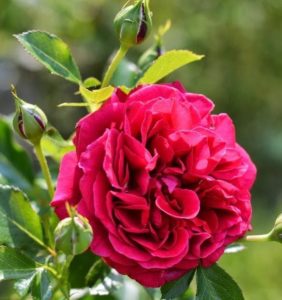
- flower diameter - from 5 to 10 cm;
- double petals, crimson-ruby or pink-apricot;
- lush bloom, lasts from June to October;
- single spherical buds.
Variety advantages:
- good indicators of frost resistance - suitability for growing in the northern regions;
- resistance to powdery mildew, cancer, gray mold;
- long and lush flowering;
- undemanding to the landing site.
Disadvantages - flowers do not tolerate drafts, require shelter for the winter.
Rugosa Alba
Another name is wrinkled rose. It features bright green leaves with wrinkles. The homeland of the plant is the Far East and Japan. The shrub is planted in April or late October.

Signs:
- shrub height and width - up to 1.5 m;
- the crown is round and dense;
- leaves are large dark green wrinkled;
- flowers are large, up to 8 cm in diameter, simple in shape, white, with a wonderful aroma;
- edible fruits, deep red, rounded, up to 2.5 cm in diameter.
Advantages:
- resistance to frost, drought, high humidity;
- easy survival in new conditions;
- long and abundant flowering;
- quick recovery after trimming or mechanical damage;
- immunity to powdery mildew, black spot.
Disadvantages - tendency to grow rapidly.The shrub occupies territory, therefore, it requires constant control over the undergrowth.
Fruits are rich in vitamin C (up to 2.75%), they are used for making healthy fruit drinks or jam.
Dominique Loiseau
The polyanthus rose from France is named after the wife of the great chef Bernard Loiseau. It is a compact remontant shrub with sparse thorny shoots.
The variety is obtained by crossing Chinese tea and multi-flowered roses.
Signs:
- height and width - from 40 to 60 cm;
- flowers are white, semi-double, fragrant, with a bright bouquet of stamens, 4–6 cm in diameter;
- the crown is round, loose;
- leaves are light green small shiny lanceolate.
Benefits:
- harmonious combination of style, shape, color mixing, aroma;
- immunity to rust, powdery mildew, gray rot, cancer;
- frost resistance;
- unpretentiousness in leaving;
- continuous flowering from June to September.
The variety is grown in the middle lane, since it does not tolerate severe Siberian frosts.
Lilac rain

This rose belongs to the scrubs. Differs in beautiful buds of a pastel lilac shade, terry petals. Requires shelter if winter temperatures drop below -20 ° C.
Features of the variety:
- height - from 70 to 100 cm;
- width - from 75 to 80 cm;
- flowers are cup-shaped, densely double, 4-5 cm in diameter, with a slight aroma;
- semi-spreading bush, uniform;
- foliage dark green semi-gloss dense.
Advantages:
- frost tolerance from -29 to -34 ° C;
- profuse re-bloom from June to October;
- unpretentious care;
- resistance to powdery mildew, prolonged rains;
- pleasant faint aroma of buds.
There are no downsides. Suitable for growing by beginner gardeners. The main thing is not to forget about timely pruning.
Santana
It is a liana-like plant with rich ruby flowers. Differs in long flowering from May to October.
Specifications:
- height - from 2.5 to 3 m;
- width - from 1.5 to 2 m;
- flowers are large-colored, ruby or red, from 8 to 12 cm in diameter, with a velvety tint;
- leaves are juicy green, with a waxy bloom;
- shoots are highly branched;
- buds form evenly over the entire height and width of the bush.
Benefits:
- cold resistance;
- long and abundant re-flowering;
- resistance to gray mold, cancer, powdery mildew;
- light pleasant smell.
The rose is suitable for vertical compositions, does not require support. Minus - exactingness to the place of growth: Santana does not like strong drafts, dark areas.
Non-covering continuously flowering varieties
Conditionally varieties of roses are divided into several categories. They differ in the characteristics of the growth of shoots and buds.
Climbing
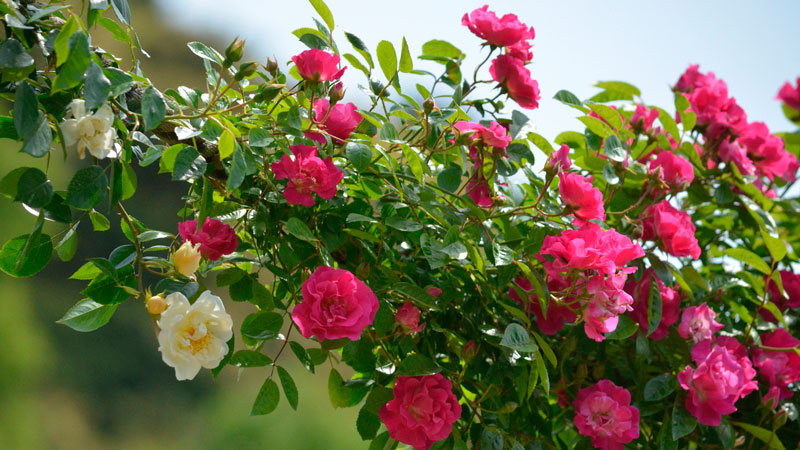
The most popular continuous flowering rose varieties:
- Aisha. A frost-resistant plant with resistance to powdery mildew and gray rot, does not require shelter for the winter. It is a densely leafy and rather voluminous shrub up to 1.5 m high. It blooms profusely and for a long time, but once. The flowers are medium, 6-7 cm in diameter, simple, rich in sunny shade. They tolerate rain well, keeping their shape. Outwardly they resemble wild rose flowers.
- Frühlingsduft. Belongs to the group of rose hips and park. It perfectly withstands severe frosts, does not require shelter for the winter, does not undergo powdery mildew and black spot. Bushes reach 2 m in height, spreading, 1.2 m wide.The flowers are creamy white, with a pink tint and a yellow center, formed early. Re-flowering is possible from May to August.
- Parade. Belongs to the Climing group, a class of large-flowered roses. It requires support, since the height of the bush reaches 4 m, and the width is 2 m. Flowering begins in mid-June and lasts until October 20. The flowers come in a variety of shades, from bright pink to cherry red. The bush perfectly withstands frosts, long rains. Resistant to black spot and powdery mildew.
Climbing roses die without support: the shoots under the weight of the buds lean to the ground and rot.Therefore, experienced gardeners create arches, walls from sustainable materials.
Semi-plaited
Such roses look good in single and group plantings, but are rarely used among florists and landscape designers.
Bright representatives of plants:
- Ave Maria. Refers to hybrid tea varieties of re-flowering roses. The flowers are bright orange, reaching 11-12 cm in diameter. The plant takes root well in the northern regions, is resistant to powdery mildew and black spot, and is not afraid of prolonged rains.
- Aelita. Large-flowered white rose. Developed by the Russian breeder Shtanko I.I. in 1952 specially for cultivation in regions with severe winters. Resistant to gray mold, not afraid of high humidity.
- Mermaid. Large-flowered, forms carmine flowers with salmon-orange tint and yellow base. Well suited for cold climates. Shoots reach 3 m, thrive in shade and partial shade.
Bush
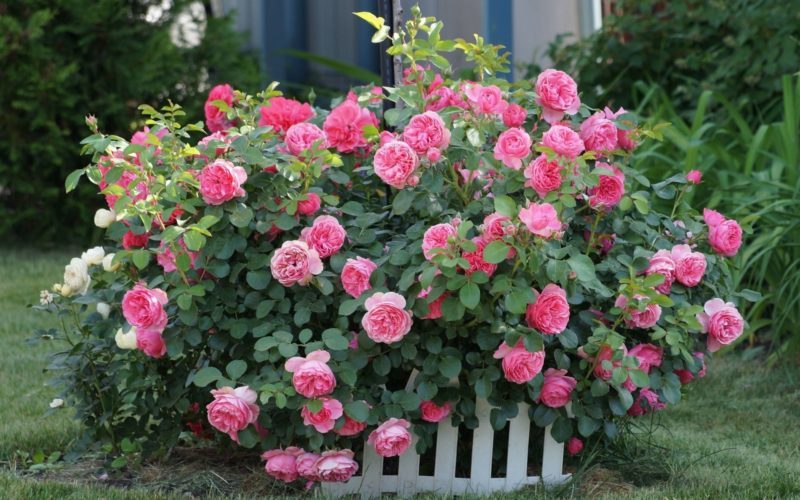
Flowers in this category are formed by bushes. What spray roses to plant in the country so that they bloom all summer:
- Romance. Shrub with large raspberry flowers (up to 12 cm in diameter), pleasant aroma. There are up to 15 buds in brushes. The rose blooms again. The foliage is lush, the shoots are densely located.
- Gartentraume. A shrub with double flowers, a very pleasant aroma. Looks good in a group planting, as a hedge. Suitable for growing in flowerpots. The flowers are pale pink, often located on the stems.
Small and large-flowered
Many gardeners pay attention to the size of the flowers. Some prefer to admire small roses, others - lush and large.
Some popular long-flowering varieties and hybrids:
- Super Excels. Small-flowered bushy rose. The flowers are bright crimson, reaching a diameter of only 4 cm.The plant does not like the scorching sun, so it is planted in partial shade.
- Polka. Large-flowered bush rose with apricot or soft coral flowers. Their diameter ranges from 25 to 30 cm. The plant blooms all summer, 2 or 3 times.
- Super Dorothy... Bright crimson small-flowered semi-leafy rose. It blooms in late May, pleases with bright buds until mid-October. Excellent against powdery mildew and black spot.
Miniature
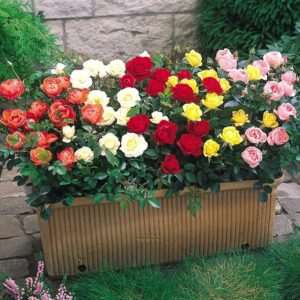
These are small copies of garden roses. They have a lush, long flowering until late autumn.
Plants are suitable for growing in cold climates, in the garden or at home.
Outstanding representatives:
- Los Angeles. Bush up to 40 cm high, with salmon flowers with a diameter of 4-5 cm. The buds evenly cover the stems, do not fade in the sun.
- Clementine. Groundcover rose with small, dense double flowers of a pale pink hue. Plant height - 60 cm. Over time, the plant turns into a dense bush. Blooms in mid-June, continues to bloom until September.
- Cinderella. Hybrid tea rose with pale pink flowers. The bushes are compact, no more than 20 cm high. They bloom 2-3 times per season. Well suited for creating an alpine slide.
How to choose a variety that will bloom all summer
Experienced growers recommend that you carefully study the description of the variety you like and pay attention to the frost resistance class: it is marked with snowflakes - the more, the better.
It is good if the rose belongs to re-flowering plants and is able to form buds up to 3 times per season.
Winter hardy varieties for different regions
Suitable for Moscow and the Moscow region Rosarium Utersen, Santana, Polka, Super Excels, Super Dorothy.
For the middle lane - Parade, Frühlingsduft, Dominique Loiseau, Watercolor, Lilac rain.
For northern regions choose Aisha, King Arthur, Rugozu Albu and other winter-hardy varieties.
Features of growing such roses
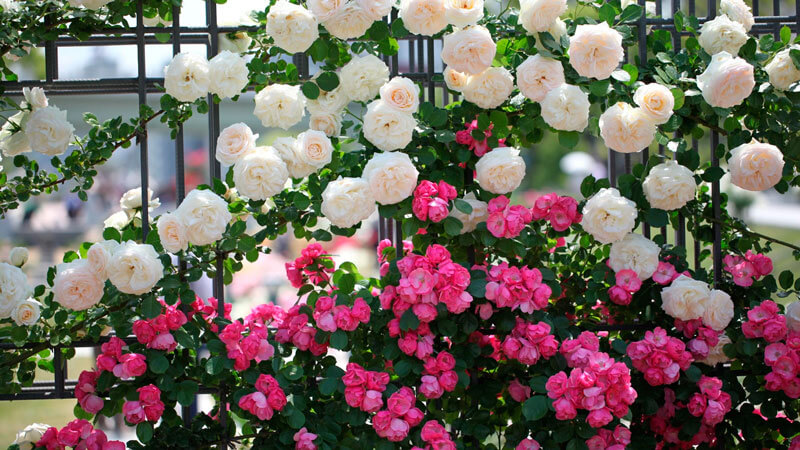
Winter-hardy roses grow in well-lit areas, without drafts and direct sunlight. The earth should be light, breathable and rich in organic matter.
Pits 60 cm deep and 50 cm in diameter are prepared for plants. The distance between them is at least 1 m. They are filled with a mixture of leafy soil, compost, fertile soil and sand in equal proportions. Add 20 g of potassium-phosphorus fertilizer per 1 m2 plot. 1 tbsp is poured into each pit. wood ash.
The seedlings are immersed in the holes, sprinkled with the remaining mixture, tamped well and watered. The top layer is mulched with straw or sawdust 8 cm thick.
Water the seedlings once a week with warm water. Up to 2 liters of liquid are poured under each bush.
Attention! Roses need to remove wilting flowers and deformed branches. Pruning spend 3-4 times per season. Bushes are formed based on personal preference.
The plants are fed 3 times for the whole season. In the spring they give rotted manure: 1/2 bucket for 1 bush. During the formation of buds, calcium nitrate is added: 3 tsp are diluted in a bucket of water. drug. Pour 0.5 l of solution under each plant. In the fall, fertilize with a ready-made mineral complex for roses. It is bought in a store, used according to the instructions.
At the end of October, the trunk circles are mulched with fallen leaves in a layer of 30 cm. Spruce branches are well suited as a shelter.
Tips from experienced florists
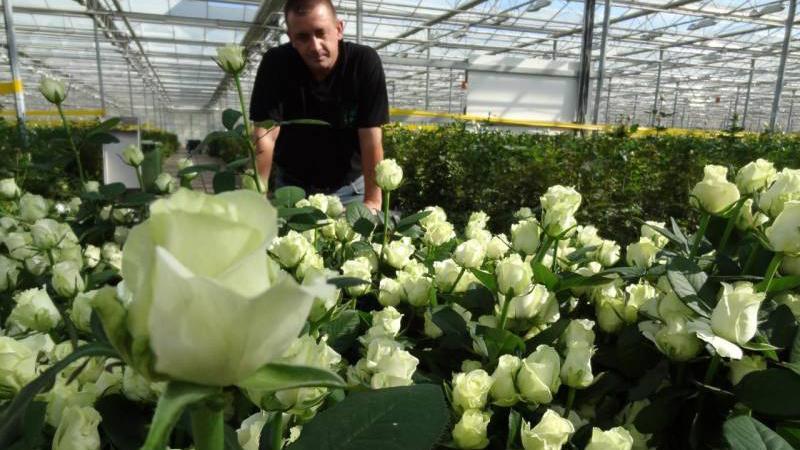
Professional rose lovers recommend for beginners:
- carefully study the description of the selected variety and the conditions for its cultivation;
- keep the distance between seedlings at least 1 m;
- prepare supports for climbing and semi-climbing roses;
- regularly inspect plants for pests and signs of disease;
- water once a week, avoiding waterlogged soil;
- do not forget about the shelter of the root system for the winter;
- regularly hold pruning to form a beautiful crown.
Conclusion
Winter-hardy varieties of roses are often chosen by residents of the middle lane and northern regions.
Plants require minimal maintenance when planted in well-lit areas without strong drafts. The only condition for preserving seedlings is to create a good shelter for the winter in the form of a layer of fallen leaves or spruce branches.